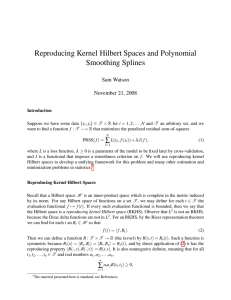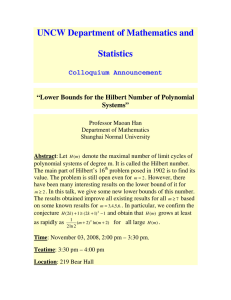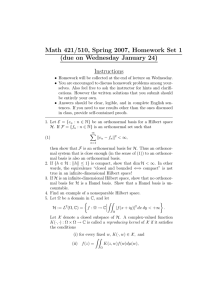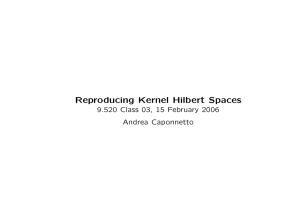An Application of Stability to Regularization in Hilbert Space
advertisement
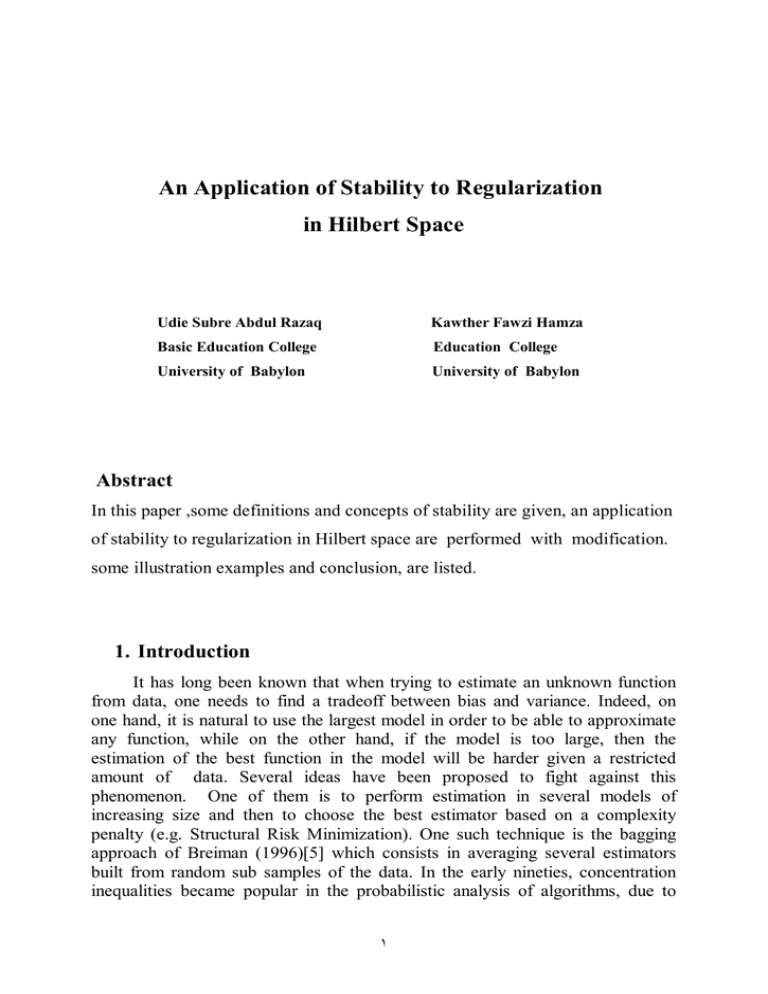
An Application of Stability to Regularization
in Hilbert Space
Udie Subre Abdul Razaq
Kawther Fawzi Hamza
Basic Education College
Education College
University of Babylon
University of Babylon
Abstract
In this paper ,some definitions and concepts of stability are given, an application
of stability to regularization in Hilbert space are performed with modification.
some illustration examples and conclusion, are listed.
1. Introduction
It has long been known that when trying to estimate an unknown function
from data, one needs to find a tradeoff between bias and variance. Indeed, on
one hand, it is natural to use the largest model in order to be able to approximate
any function, while on the other hand, if the model is too large, then the
estimation of the best function in the model will be harder given a restricted
amount of data. Several ideas have been proposed to fight against this
phenomenon. One of them is to perform estimation in several models of
increasing size and then to choose the best estimator based on a complexity
penalty (e.g. Structural Risk Minimization). One such technique is the bagging
approach of Breiman (1996)[5] which consists in averaging several estimators
built from random sub samples of the data. In the early nineties, concentration
inequalities became popular in the probabilistic analysis of algorithms, due to
١
the work of McDiarmid (1989) and started to be used as tools to derive
generalization bounds for learning algorithms by Devroye (1991). Building on
this technique, Lugosi and Pawlak (1994) obtained new bounds for the k-NN,
kernel rules and histogram rules.
A key issue in the design of efficient machine learning systems is the
estimation of the accuracy of learning algorithms. among the several
approaches that have been proposed to this problem, one of the most prominent
is based on the theory of uniform convergence of empirical quantities to their
mean .this theory provides ways to estimate the risk (or generalization error) of a
learning system based on an empirical measurement of its accuracy and measure
of its complexity, such as the Vapnik-Chervonenkis(VC)dimension or the fatshattering dimension. We explore here a different approach which is based on
sensitivity analysis .sensitivity analysis aims at determining how much the
variation of the input can influence the output of a system .it has been applied to
many areas such as statistics and mathematical programming .in the latter
domain ,it is often referred to as perturbation analys.
Uniform stability may appear as a strict condition . actually we will observe
that many existing learning methods exhibit a uniform stability which is
controlled by the regularization parameter and thus be very small. many
algorithms such as Support Vector Machines(SVM) or classical regularization
networks introduced by Poggio and Girosi (1990)[9] perform the minimization
of a regularized objective function where the regularizer is a norm in a
reproducing kernel Hilbert space (RKHS):
N ( f ) // f // k
2
, where k refers to the kernel.
2. Some Definitions and Concepts
Def.(1) Learning Algorithm [ 4]:- a learning algorithm is a function A from Z m
into F Y x which maps a learning set S onto a function AS from X to Y ,such
that X , Y R are an input and output space respectively , and S a training set
S {z 1 (x 1 y1 ), . . . z m (x m , y m ) , of size m in Z X Y drawn i.i.d. from an
unknown distribution D.
Def.(2) Stability [3]:- consider the system
x(t ) f [ x(t ), u(t )], x X R n , u U R m ,
A stable x is an equilibrium state if there exists u such that f ( x , u ) 0.
٢
Def.(3) Hilbert Space [2]:- An inner-product space which is infinite dimensional
and complete is called a Hilbert space (real or complex ,according to whether
the scalar filed is real or complex).
Def.(4) Hypothesis Stability [ 8] :-An algorithm A has hypothesis stability
with respect to the loss function
if the following holds
[/ ( A , z ) /] .
S
S, Z
Note that this is the L1 norm with respect to D, so that we can rewrite the above
as E S [ ( AS ,.) ( AS ,.) ] .
i {1,..., m}, E
\i
Def.(5) Pointwise Hypothesis Stability[8]:- An algorithm A has point wise
hypothesis stability with respect to the loss function if the following holds
i {1,..., m}, E [/ ( A , z ) ( A , z ) /] .
S
S i
S\ i i
Another, weaker notion of stability was introduced by Kearns and Ron. It
consists of measuring the change in the expected error of the algorithm instead
of the average pointwise change.
Def.(6) Error Stability[ 3]:- An algorithm A has error stability . with respect to
the loss function if the following holds
S Z m , i {1,..., m}, E [( A , z )] Ez[( A
, z )] ,
z
S
S\i
Which can also be written
S Z m , i {1,..., m}, R ( S ) R \ i ( S ) .
Def.(7) Uniform Stability[9 ]:- An algorithm A has uniform stability with
respect to the loss function if the following holds
S Z m , i {1,..., m}, ( AS ,.) ( AS \ i ,.)
.
Def.(8) convex set [2 ]:- A set S in vector space X on the field F, is called
convex if
x (1 ) y S ,
x, y S , 0 1
i.e
S (1 ) S S
٣
Def.(9) A loss function[6 ] :-A loss function defined on F Y is -admissible
with respect to F if the associated cost function c is convex with respect to its first
argument and the following condition holds
y , y D , y Y , c ( y , y ) c ( y , y ) y y ,
1 2
1
2
1 2
Where D { y : f F , x X , f ( x ) y }
is the domain of the first
argument of c. thus in the case of the quadratic loss for example ,this condition
is verified if Y is bounded and F is totally bounded, that is there exists M
such that
f F , f M and y Y , y M , such that F is a convex subset of a linear
space.
Def.(10) Classification Stability[5 ] :- a real-valued classification algorithm A has
classification stability if the following holds.
S Z m , i {1,..., m}, AS (.) AS \i (.)
.
3. Survey of Online Kernel Methods[6]
The perception algorithm (Rosenblatt, 1958) is arguably one of the simplest
online learning algorithms.
Given a set of labeled instances {(x 1 y1 ), (x 2 , y 2 ) . . . (x m , y m ) ⊂ X ×Y where X ⊆ Rd
and y i ∈ {±1} the algorithm starts with an initial weight vector 0 . It then
predicts the label of a new instance x to be yˆ sin g ( , x ). . If ŷ differs from the
true label y then the vector 0 is updated as yx. This is repeated until
all points are well classified. The following result bounds the number of
mistakes made by the perceptron algorithm (Freund and Schapire, 1999,
Theorem 3) this generalizes the original result for the case when the points are
strictly separable , i.e, when there exists a such that 1 and y i , xi
for all xi , y i .the so-called kernel trick has recently popularity in machine
learning . as long as all operations of an algorithm can be expressed with inner
product ,the kernel trick can used to lift the algorithm to a higher-dimensional
feature space: the inner product in the feature space produced by the mapping
: is represented by a kernel k ( x, x ) ( x ), ( x ) . We can now drop the
condition X ⊆ Rd
space (RKHS).
but instead require that H be a reproducing kernel Hilbert
٤
4. Some Theorems About an Application of Stability to
Regularization and Illustration Examples
Many algorithms such as Support Vector Machines (SVM) or classical
regularization
networks introduced by[9] perform the minimization of a
regularized objective function where the regularizer is a norm in a reproducing
2
N ( f ) // f // k , kernel Hilbert space(RKHS):
where k refers to the kernel .the fundamental property of a RKHS
F is the so-called reproducing property which writes
f F, x X , f ( x) f , k(x,.) .
.…..(2)
In particular this gives by Cauchy-Schwarz inequality
f F , x X , f ( x) f
k
k ( x, x )
...…(3)
Theorem (1):[8 ]
let F be a reproducing kernel Hilbert space with kernel k such that
x X , k ( x, x) 2 . let be -admissible with respect to F .the
learning algorithm A defined by
2
1 m
( g , zi ) g k ,
A arg min
gF m i 1
S
Has uniform stability with respect to with
2 2 .
2 m
Proof
….(4)
We have
2
d N ( g , g ) g g k .
Thus, by the (Let be admissible with respect to F, and N a functional defined on F
such that for all training sets S, Rr and Rr\ i have a minimum (not necessarily unique ) in F
.let f denote a minimizer in F of Rr , and for i=1,..,m ,let f \ i denote a minimizer in F of Rr\ i
.we have for any t=[0,1] ,
t
N ( f ) N ( f tf ) N ( f \ i ) N ( f \ i tf )
f ( xi ) , where f ( f \ i f ). ) ,gives
m
2f
2
k
f ( x i ) .
m
٥
Using (2),we get
f ( xi ) f
k
k ( xi , xi ) f k ,
So that
.
2 m
Now we have ,by the -admissibility of
f
k
( f , z ) ( f \ i , z ) f ( x ) f \ i ( x ) f ( x ) ,
…….(4)
Which ,using (2)again , gives the results.
Theorem (2):[8 ]
Let A be the algorithm of theorem(1) where is a loss function associated to a
convex cost function c(. , .) .we denote by B(.) a positive non-decreasing realvalued function such that for all y D .
y Y , c( y, y ) B( y )
For any training set S, we have
f
2
k
B ( 0)
,
…… (5)
And also
z Z ,0 ( AS , z ) B(
B(0)
)
Moreover , is -admissible where can be taken as
sup y Y sup
y B (
B ( 0)
)
c
( y, y )
y
Proof
We have for
f As ,
1 m
Rr ( f ) Rr (0) (0, z i ) B(0),
m i 1
2
And also Rr ( f ) f k which gives the first inequality .the second inequality
follows from(3) .the last one is a consequence of the definition of admissibility.
٦
Theorem (3):[1 ]
Let {(x 1 y1 ), (x 2 , y 2 ) . . . (x m , y m ) be a sequence of labeled examples with ||xi|| ≤
R. Let be any vector with || || = 1 and let >0. Define the deviation of each
example as
d i = max (0, - y i , xi ), and let D = i d i 2 . Then the number of mistakes of
the perception algorithm on this sequence is bounded by (
RD
)2.
Theorem (4): [8 ]
Let A be an algorithm with uniform stability with respect to a loss
0 ( AS , z ) M , for all z Z and all sets S .then ,for
function such that
any m 1 , and any (0,1), , the following bounds hold with probability at least
1 over the random draw of the sample S,
R Remp 2 (4m M )
ln 1 /
,
2m
…….(6)
And
R Rloo (4m M )
ln 1 /
.
2m
………(7)
Example (1);[8 ]
stability of bounded SVM regression
Assume k is a bounded kernel, that is k ( x, x ) 2 and Y=[0,B].
Consider the loss function
o
( f , z ) f ( x ) y
f(x) - y
if f(x) - y
otherwise
This function is 1-admissible and we can state B(y)=B .the SVM algorithm for
regression with a kernel k can be defined as
And we thus get the following stability bound
2 2
.
2m
AS argmingF
2
1 m
(g, zi ) g k , Moreover, by theorem (2) we have
m i1
٧
z Z ,0 ( AS , z )
B
Plugging the above into theorem (4) gives the following bound
R Remp
2
2 2
B ln 1 /
(
)
m
2m
…….(8)
Such that Remp is the simplest estimator (empirical error).
Example(2):[11]
Absolute stability of control system
Suppose system of differential equation
………(9)
x Ax ,
Is represent the free motion to body .such that
A aij matrix of order n n ,constant and stable matrix and non-singular.
Let x is vector (column) in R n and let system of control arbitress by the
following equation
x Ax ub
u f (Z )
……… (10)
T
Z c x pu
Such that c, b are constant vectors in R n and c T is transpose to vector c . p and u
are elements in R and f is element in admissible characteristic function , then
system (10) is absolutely stable if for all solution ( x ,u) to system(10) is
( x (t ), u (t )) (0,0) when t is converge to .the variable of control of system (10)
is u ,let us take transformation
x y
z c T x pu
That trans the system (10) to the new formal following ;
y Ay bf ( z )
…… (11)
z x T y pf ( z )
Its keep on the estate stability ,we must that transformation non-singular ,that is
A
b
T
p
c
0 , then
p c T A 1b
So the original point is unique control point of system (11) .
٨
Example (3):[10]
stability of regularized least squares regression
We will consider the bounded case Y=[0,B] .the regularized least squares
regression algorithm is defined by
2
1 m
( g , z i ) g k ,
m i 1
Where ( f , z ) ( f ( x) y ) 2 .
We can state B( y ) B 2 so that is 2B-admissible by theorem (2) .also we have
AS arg min gF
z Z ,0 ( AS , z )
B
.
The stability bound for this algorithm is thus
2 B 2 2
m
So that we have the generalization error bound
R Remp
4 B 2 2
8 2 B 2
ln 1 /
(
2 B)
.
m
2m
……..(12)
Remark
The function f is said to be element in admissible characteristic function
, if
1. f is function defined and continues on (, )
2. f (0) 0 , xf ( x) 0 for x 0
3.
0
0
f ( s )ds
and
f ( s)ds
are existes.
5. Conclusions
There are many ways to define and quantify the stability of a learning
algorithm. The natural way of making such a definition is to start from the
goal : we want to get bounds on the generalization error of specific
learning when the algorithm and we want these bounds to be tight when
the algorithm satisfies the stability criterion. Such as support vectors
machines (SVM) or classical regularization networks perform the
minimization of a regularized objective function where the regularizer is a
norm in a reproducing kernel Hilbert space .we introduced definitions and
examples of types of stability and some concepts that we needed us. The
results about the uniform stability of (RKHS) learning are given .
٩
References
[1]. AlexJ.Smola, NicolN. Schraudolph and S.V.N.Vishwanathan, "Step Size
adaptation in reproducing kernel Hilbert space",1107-1133, research school
of information sciences and engineering ,Australian national
university,(2006).
[2].
Anguse.Taylor,"introduction
to
functional
analysis",(1962),new
york,London.
[3]. Casagrande.D,"stabilization of the equilibrium of non-holonomic systems
by means of switching control laws",italy,(2006).
[4]. Cortes and V. Vapnik. Support vector networks. Machine Learning,
20(3):273–297, 1995.
[5]. Breiman,L,." Heuristics of instability and stabilization in modelselection".
Annals of Statistics, 24(6):2350–2383, 1996b.
[6]. Wenye li,Kin,Kwong Leung, "Generalized Regularized Least-Squares
Learning with Predefined Features in a Hilbert Space" ,department of
computer science and engineering, the Chinese university of hong kong.
[7]. O. Bousquet and A. Elisseeff. " Stability and Generalization". Journal of
machine learning research 2,499-526 ,(2002) ,New-York.
[8]. O. Bousquet and A. Elisseeff. "Algorithmic Stability and Generalization
Performance". In Neural Information Processing Systems 14, (2001).
[9]. T. Poggio and F. Girosi. "Regularization algorithms for learning that are
equivalent to multilayer networks". In Science, 247(2):978–982, (1990).
[10] . G. Wahba. "An introduction to model building with reproducing kernel
Hilbert spaces". Technical Report Statistics Department TR 1020,
University of Wisconsin, Madison, (2000).
[11]. ﻣﻄﺒﻌﺔ اﻟﺘﻌﻠﯿﻢ اﻟﻌﺎﻟﻲ،" " اﻟﻤﻌﺎدﻻت اﻟﺘﻔﺎﺿﻠﯿﺔ اﻻﻋﺘﯿﺎدﯾﺔ وﻧﻈﺮﯾﺔ اﻻﺳﺘﻘﺮار. ﺧﻠﯿﻞ اﺳﻤﺎﻋﯿﻞ، ﻃﮫ
. (١٩٩٠) ﺑﻐﺪاد،
اﻟﻤﻠﺨﺺ
ﺗﻢ ﻋﺮض ﺑﻌﺾ اﻟﺘﻌﺎرﯾﻒ وﻣﻔﺎھﯿﻢ اﻻﺳﺘﻘﺮار وﺗﻄﺒﯿﻖ اﻻﺳﺘﻘﺮار ﻟﻠﺘﻨﻈﯿﻢ ﻓﻲ ﻓﻀﺎء، ﻓﻲ ھﺬا اﻟﺒﺤﺚ
.أدرﺟﺖ ﻣﻊ اﻻﺳﺘﻨﺘﺎﺟﺎت، ﺑﻌﺾ اﻻﻣﺜﻠﮫ واﻟﻨﻈﺮﯾﺎت اﻟﺘﻮﺿﯿﺤﯿﺔ. ھﻠﺒﺮت ﻣﻊ اﻟﺘﻌﺪﯾﻞ
١٠


